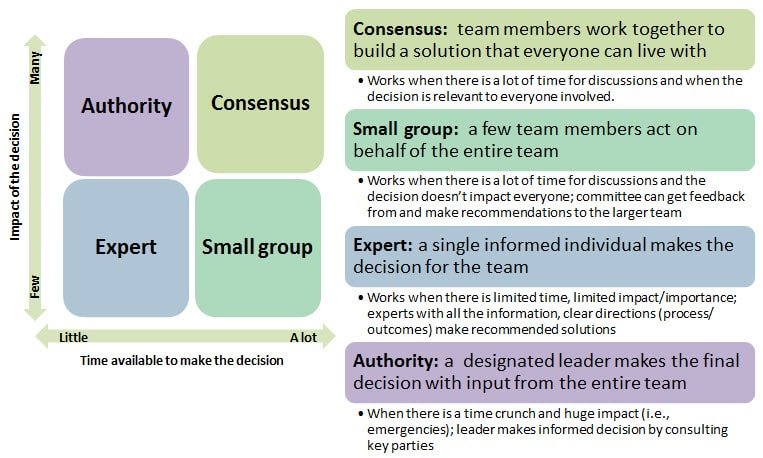The actual problem-solving process in a remote team may not be different to that in any other environment. But when a team is distributed globally, constraints like time differences may pose additional challenges.
With a few tweaks, however, the basic problem-solving framework can be seamlessly adapted to fit remote work. (And if you’re thinking, “what shall I do with a remote team problem-solving checklist when I don’t even have a remote team member?” – Let’s rectify that, shall we? Contact us now.)
American Society for Quality outlines problem-solving in four necessary steps: define the problem, generate alternative solutions, evaluate and select an alternative, and implement and follow-up on the answer.
The most significant change to that structure for remote teams is adding clear instructions about the hierarchies and protocols to follow when problems crop up. Other factors can affect remote team problem solving – such as team culture.
Here’s a checklist to help you navigate problem-solving in a remote team.
Defining the Problem
Having a clear idea of what the problem is and how it affects the project, is the first step in solving any problem.
- Nature of the Problem – Knowing the nature of the problem (technical, process-oriented, decision-making) will help streamline whom to involve and what to do. For instance, whether to use a squeeze page or a sign-up form may involve the team lead and designer. But changing the coding language would need approvals from managers and clients.
- Root Cause Vs. Symptomatic Vs. Repetitive Problem – If urgent, a symptomatic problem should be solved immediately. Whereas, with sufficient time, it might be more efficient to find the cause and eliminate that. Repetitive issues almost always have a deeper cause.
- Problem Alert System – Classifying problems using something like an emergency alert system is useful when all team members aren’t present in the same place. It’ll let the team know whether it’s an all-hands-on-deck situation or something less pressing.
Hierarchies and Protocols to Follow
In a remote team, a manager/team lead/SME might not be around all the time to deal with problems as they arise. Therefore, the following protocol is indelible to maintaining order, keeping everyone informed, and knowing how to proceed.
- Communication Platforms – Remote communication tools (like Slack) are indispensable for virtual teams. But there should be one agreed-upon tool with which the entire team can be reached. Especially during emergencies.
- Remote Management Tools – Many iterations, changes in requirements, task delegation, and time management – are all part of problem-solving. Using remote management tools, like Asana or Trello, will help keep track of the different variables.
- Division of Labor – In an agile environment, working with cross-functional teams, everyone needs a clear idea of what part of the problem they’re solving. That along with lateral thinking and breaking up the problem will help solve it quicker.
- Time Limit For Remote Teams – Since a team distributed globally might not be reachable at once, response times from its members should be fixed. Without this, it will be challenging to keep everyone in the fold and utilize all resources to solve problems.
- Code Red Situation – Crises warrant a different set of protocols. Emergency contact modes, shortened response times, knowing whom to ask for help (both on the project team and the client’s point of contact) will help the remote team to solve the problem faster.
- Unknown Problems – Provisions should be made for when an unforeseen issue crops up. Adding a new feature to an app or changing a deadline, while unplanned, are regular software development phenomena. And the remote team should know how to proceed then.
- Keeping Notes – Keeping all the iterations, changes, and notes in one place (in the project management tool) will help everyone remain accountable and maintain order.

Image Source: The George Washington University
Generating Solutions and Picking the Best Alternative
Depending on the nature of the problem, the remote team should have a good idea about whether they’ll be involved in the problem-solving process or not.
- Brainstorming in Groups – Ideally, solving a problem related to a project should involve everyone working on it. This would increase the chances of considering the problem from different points of view and getting at the best solution. For a remote team, this means pulling the group together on a video call on Skype or Zoom.
- Authoritarian Decision – When the problem isn’t relevant, or there isn’t enough time to involve everyone, the project managers and experts would come up with probable solutions.
- Metrics of an Optimal Solution – Based on metrics like how long it’ll take to implement, how it’ll affect other goals and sub-goals, how much resources it’ll use, the best solution can be chosen.
Implementing the Optimal Solution
Implementing the solution might involve redistributing tasks and roping in help from another team. Everyone on the team should be on the same page about their new roles.
- Who is Involved – Not everyone would be involved in implementing the solution. But they may be required for occasional technical consultation or work/time management help.
- Timeframe – Clear timeframes should be set for executing the solution, considering the overall project deadline and how it ties in with other project goals.
- Re-Delegating Tasks – While a part of the team is working on the solution, the rest of the team members might have to step in and manage other aspects of the project to meet deadlines.
Team Culture
Although not directly a part of the problem-solving process, the right team culture can be the first line of defense in the face of any problem. Here are a few dos and don’ts that’ll enable a remote team to work through a problem together:
- Foster an environment of free-thinking
- Encourage intellectual diversity and experimentation
- Don’t micromanage, but give some leeway
- Encourage collaboration
- Prepare new remote members on the requisite protocols
Having a problem-solving checklist can simplify some of the processes and control chaos while facing a problem. So the team can focus on the actual work.
Yet a checklist can never genuinely encompass every aspect of problem-solving. That requires remote team members who’d know how to think on their feet, are flexible, and will do the best for the project, regardless of time or amount of work. We can help you find such candidates, who, besides, will work according to your work hours. Let us know when to get started.





